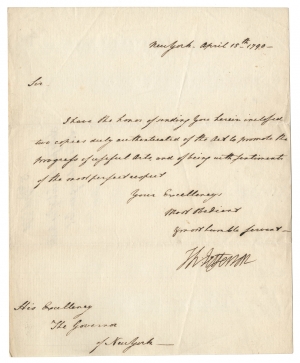|
Thomas Jefferson Transmits the First Patent Act to Governor of New York George Clinton, Who Later Replaced Aaron Burr as Jefferson’s Vice President |
Click to enlarge:

Select an image:
In his position as Secretary of State, Thomas Jefferson conveyed copies of new federal laws to the governors of each of the states. This letter, signed by Jefferson, conveyed the First Patent Act, formally An Act to Promote the Progress of Useful Arts, to New York Governor George Clinton, who would later serve as Jefferson’s second vice president.
THOMAS JEFFERSON.
Letter Signed, as Secretary of State, to Governor George Clinton of New York, April 15, 1790, New York. 1 p., 7¾ x 9½ in
Inventory #26389.99
Price: $32,000
Complete Transcript
New York, April 15th 1790.
Sir,
I have the honor of sending you herein inclosed two copies duly authenticated of the Act to promote the progress of useful Arts, and of being with sentiments of the most perfect respect
Your Excellency’s
Most Obedient / & most humble servant,
Th: Jefferson
His Excellency / The Governor / of New York.
[Docketing in Clinton’s hand on integral leaf:]
15th April 1790 / Letter from the Secry of the United States inclosing an Act.
Historical Background
On April 10, 1790, the First Federal Congress passed An Act to Promote the Progress of Useful Arts. It granted an applicant the “sole and exclusive right and liberty of making, constructing, using and vending to others to be used” an invention. It made the Secretary of State, the Secretary of War, and the Attorney General into a Patent Board with the title of “Commissioners for the Promotion of Useful Arts,” who had the authority to grant a successful applicant a patent for up to fourteen years.
Because the process of reviewing applications required thorough and careful inspection by the Secretary of State, it proceeded slowly. Only fifty-seven patents were issued during the three years that the 1790 Patent Act was in effect. The law also established a process for defending patents through lawsuits that charged infringement.
Inventors complained that patents were too difficult to obtain, and Thomas Jefferson became a vocal critic of the process established by the act, and in December 1791 drafted a replacement.
In February 1793, Congress passed the Second Patent Act, repealing the first. The new law simplified the process by directing applicants to petition the Secretary of State, who could require an examination by the Attorney General. The revised law dropped the requirement that patented inventions had to be “sufficiently useful and important,” so obtaining patents became much easier. It established the subject of patents as “any new and useful art, machine, manufacture or composition of matter and any new and useful improvement on any art, machine, manufacture or composition of matter.”
Ten thousand patents were issued over the next forty years, and courts soon became overwhelmed with patent lawsuits.
The Patent Act of 1836 reformed the process again by replacing the Secretary of State’s role with a Patent Office, which greatly improved the quality of patents granted by requiring research on related patents. It also permitted a possible extension of seven years on the original 14-year patent and made it possible for foreigners to obtain U.S. patents.
Secretary of State’s Role in Transmitting to the States Signed Acts of Congress
A September 15, 1789 Act of Congress required the Secretary of State (then Thomas Jefferson) to sign two copies of each law, order, vote, or resolution of Congress for distribution to the executive of every state.
The recipient, George Clinton(1739-1812) was born in New York to Irish parents. He served on a privateer in the Caribbean and then in the militia during the French and Indian War. He began to practice law in 1764, and served in the New York Provincial Assembly from 1768 to 1776. He was a delegate to the Second Continental Congress from May 1775 to July 1776. Commissioned as a brigadier general in the New York militia, Clinton was absent from many of the sessions of the Congress, so he resigned (before New York delegates received permission to sign the Declaration of Independence). In March 1777, he received a commission as brigadier general in the Continental Army but began serving as the first governor of the State of New York in late July 1777. Re-elected five times, he served until 1795, He was nominated by the Democratic-Republican Party as its vice-presidential candidate in 1792. He was again elected governor, serving from 1801 to 1804, until he was chosen to replace Aaron Burr as President Jefferson’s running mate. He ran against James Madison for the presidency in 1808. Before the 11th Amendment, his second place finish again made him Vice President.
Condition: Pencil notations on recto and verso. Lightly toned with some minor soiling. Smoothed folds.